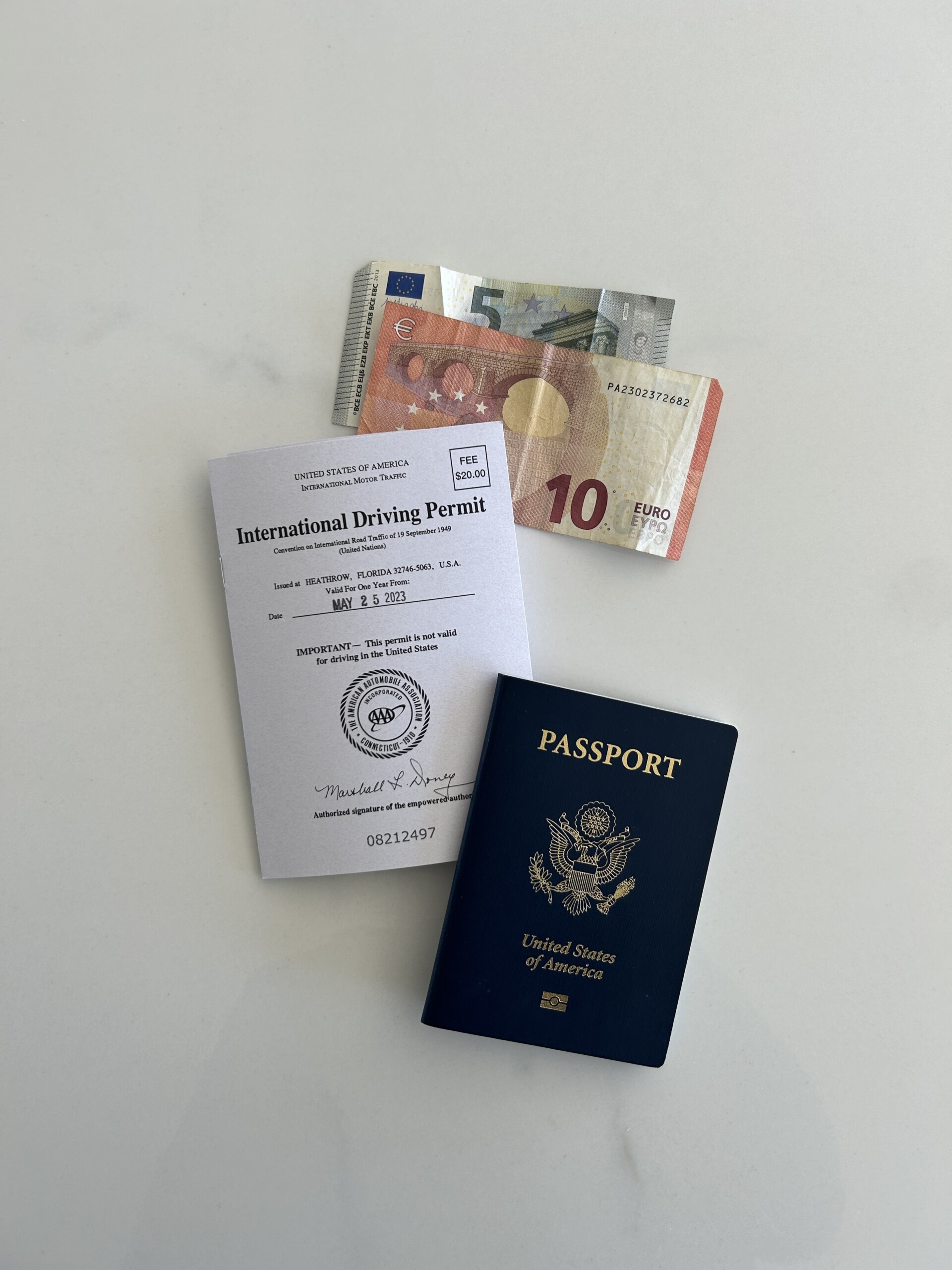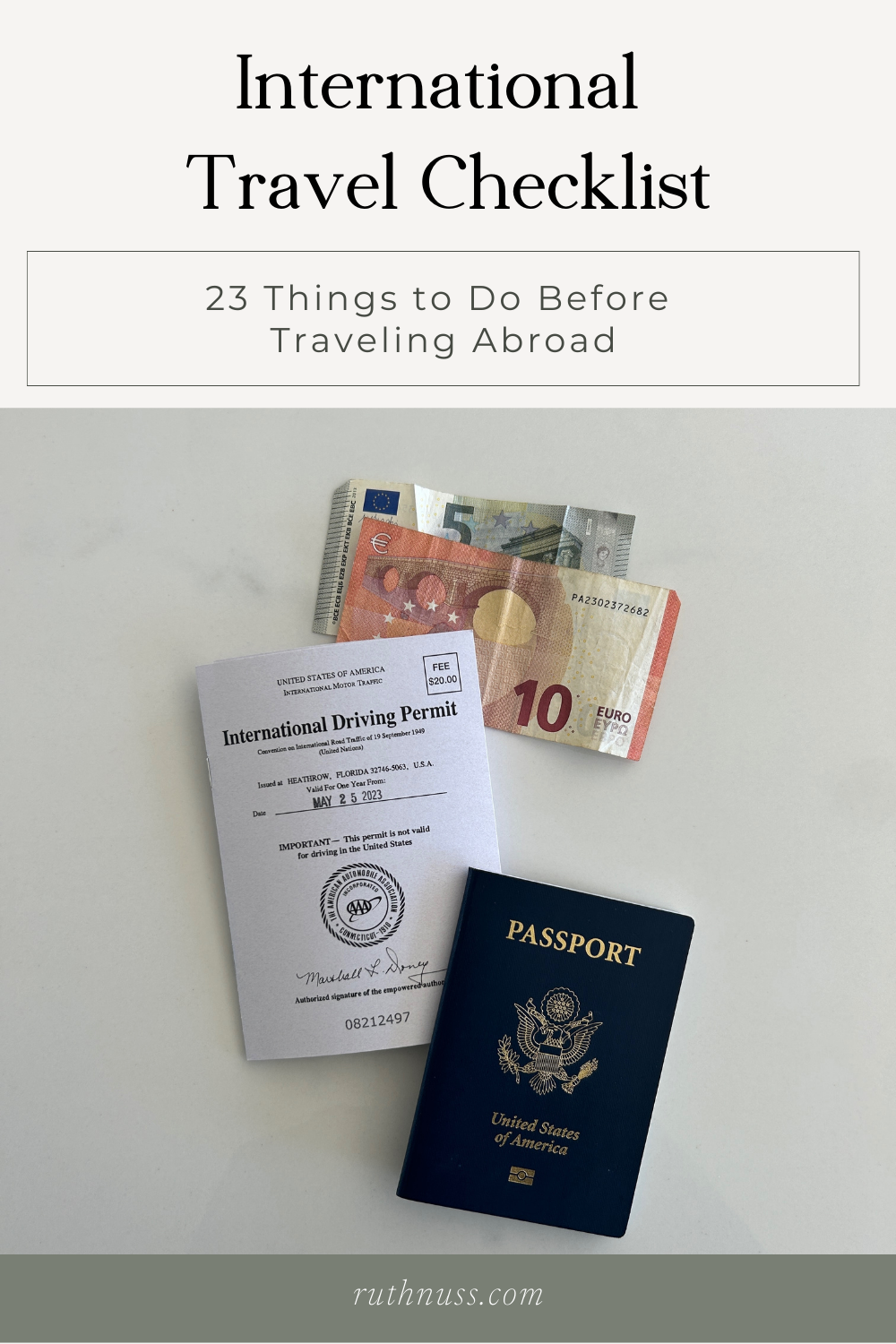
The Ultimate International Travel Checklist: 23 Things to do Before Traveling Abroad
Today I’m sharing my international travel checklist. This is a basic roundup of things to do before traveling abroad and something I try to check in with before every big trip we take.
This list includes all of the somewhat boring but necessary administrative tasks that go along with a trip abroad. I linked all of the helpful sites that go with each to-do item within the post.
The most helpful site for all of this is the state department website (I know, a government site being helpful seems too good to be true, but it’s legit, I promise). I’ve linked the most relevant pages from that site within this post as well, but it’s a good one to bookmark when you’re preparing for a trip.
Also! I consolidated this guide into a cute printable checklist. Enter your email below to get the pdf if you are interested.
Here is a list of things to do before traveling abroad.
International Travel Checklist:
Make sure you have a valid passport
The US state department has a really helpful passport information page that walks through the process. It looks like the current standard processing time is 6-8 weeks, and the expedited timeline is 2-3 weeks.
If you need a passport, I recommend making an appointment at a passport center near you as soon as you book a trip–or if you even *think* you might be going on a trip, really!
The state department website has a database that you can use to find the centers closest to you. These appointments can be hard to get, so that’s why I recommend doing this way ahead of time.
The website also has a checklist of the list of things you need to bring with you to the appointment. Once you make the appointment, make sure to note whether or not that location you selected offers photo services as well. If not, you’ll need to bring photos with you.
The process is largely the same for kids and babies. You’ll need to bring all of their paperwork, and both parents have to be present at the appointment (with photo IDs and copies). This page gives a rundown on what exactly you need to bring.
OH, and you have to pay by check at the appointment. (Tyler had to run home to get our checkbook during ours last year while the girls and I tap danced around trying to stall and beg the lady to hold our appointment time, lol).
If you simply need to renew your passport, you can do this by mail. You’ll want to do this if your passport is expiring anytime within six months of your return date.
Adult passports are valid for 10 years. For children under 16, passports are valid for 5 years.
Check for safety advisories
When you’re in the planning stage, you’ll want to make sure to double check for any safety advisories for the country you are considering visiting. The state website rates each country on a scale of 1-4 (ranging from “exercise normal precautions” to “do not travel”) along with an explanation for the rating. The rating considers factors such as terror threats, civil unrest, environmental hazards, political tension (resulting in unlawful detentions or what have you).
Check for health advisories
In the same vein, check out this page on the CDC site for any health-related travel restrictions for your destination.
Obtain any necessary visas
Depending on where you are traveling (and for how long), you may need to obtain a visa. Search for your destination country on this database for any relevant updates; if you scroll down you can see the visa category which will indicate and link to any visa requirements.
(Never forget the time Tyler and I found out about the visa we needed to visit Australia less than 12 hours before our flight, lol. Fortunately, it was just a short form, but it could have been a trip ruiner otherwise. Don’t be like us, lol!).
Check in on vaccinations and medications
You’ll want to make sure your vaccinations are up to date and check to see if you need to bring any certain destination-specific medications with you (malaria pills, etc).
Also, take care to bring enough of any prescription medications you may need on your trip.
Get a travel credit card
If you don’t already use a travel credit card, there’s no better time to start than when you are planning a trip. Many cards (such as the Chase Sapphire Reserve) offer sign-on bonuses in the form of points which you can put towards your flights or hotels. These cards also offer 2-3x reward points on dollars spent on travel-specific expenses. Paying for your bookings with a travel credit card is the best way to make your travel expenses work for you.
Perhaps more importantly, there are TONS of travel-related perks with these cards. The Chase Sapphire Reserve, for example, offers a $300 annual travel credit, reimbursement for TSA PreCheck and Global Entry, access to airport lounges, trip cancellation or delay insurance, lost luggage reimbursement, auto collision damage waiver (meaning you can decline the expensive insurance offered through car rental companies!), and much more.
The Points Guy has a great page that covers all of the best travel cards and their benefits.
Of course, we’re all adults here, so you don’t need me to tell you to be responsible with your credit cards!
International Driving Permit
If you’re renting a car abroad, you’ll want to apply for an international driving permit.
I’m embarrassed to admit that we’ve actually never done this before, despite having rented cars on several international trips, but my brother got after me about it a few weeks ago. And since our trip is so long this summer, we decided to go ahead and get one. Luckily, the process is very simple!
You can download the form online and submit it either in person at your local AAA or via mail. You do need to submit passport pictures with the application. AAA offers this in person, so if you need pictures you might want to go that route. Tyler went to our local AAA office and the entire process took him about 30 minutes–they issued the permit to him right on the spot.
Health Insurance
Familiarize yourself with your health insurance policy on international travel. At a minimum, you may want to purchase emergency evacuation insurance–although this too is covered by the Chase Reserve credit card!
Register with STEP
Once your trip is booked, visit the state department STEP program website to register your trip. First, you’ll enter your name and contact information and then you can input your itinerary. Basically, this puts you on the state department’s radar in case, God forbid, something happens while you are abroad. If a terrorism attack or natural disaster occurs, the US will know that you are there and need to be tracked down, etc. They also have you offer an emergency contact just in case. This all sounds morbid, I know, but I find it oddly comforting actually.
TSA PreCheck
TSA PreCheck is a no-brainer. It’s relatively easy to get and will save you SO much time at security on travel days. You can also keep your shoes on and your laptop in your bag which, to me, is the pinnacle of elite travel.
Enrollment costs $78 and lasts for five years. You apply online and then get fingerprinted in person at the airport in the TSA office (takes 10 minutes). Once you’re enrolled, you will be able to enter your Known Traveler Number (KTN) with your passenger information when you book your trip (call your airline to have it added to your booking if you get your KTN after you’ve already booked your flight).
You can renew online after the first five years are up–I did that this past year and it was so simple and costs $70.
The best part is that most travel credit cards cover the cost of TSA PreCheck and Global Entry (will cover that next) as a perk.
Note: TSA PreCheck is a US program, so this will only save you time on your way out of the country or if you’re traveling domestically.
Global Entry
Speaking of elite travel, the Global Entry program allows trusted, low-risk travelers to skip the line at customs upon entering the US at major airports.
This program is a bit more time intensive, as the timeline is longer and you have to do an in-person interview which can be hard to get. You can either schedule an interview once you’re conditionally approved OR opt for an interview upon arrival after your next trip if your airport offers them.
Global Entry status actually includes TSA PreCheck, making this the ultimate two-birds travel situation.
The big draw is that Global Entry members don’t have to fill out any paperwork upon landing. They simply use the Global Entry self-service kiosks to make their way through the customs area.
Mobile passport
If you don’t have time to get Global Entry status before your trip, the good news is that anyone can download the mobile passport app.
With this app, you can create a profile with your passport information prior to your trip. Upon landing in the US, you use the app to upload a picture of yourself and fill out the questionnaire. You will then be provided a QR code which you can present with your physical passport.
You still have to be processed by a CBP officer at customs, but you will be directed to a mobile passport-specific entryway for a streamlined process.
This app has helped save us a ton of time in the past, and just one family member can have the app and use it to input your entire party’s information.
Cell phone coverage
Personally, I think it’s kind of a rite of passage to travel without cell service. It’s a fun way to “lose yourself” in a new place and really be present in the moment.
However, the safer thing to do is be reachable in case of an emergency, I suppose. And now that we have a family and kids to look after, better safe than sorry!
Many providers offer international data packages for a fee with a limited amount of data for use over the course of the trip.
T-Mobile offers GREAT travel benefits with their Magenta and Magenta Max plans–we’ve been with a few different providers over the years and T-Mobile is by far the most travel-friendly, offering 5GB of data and texting in over 215 countries.
Download the offline version of Google Maps
If you’re traveling with limited cell coverage, you might want to download the offline version of Google Maps for the destination you are visiting. You can select the area of the map you’ll need once you’re “off the grid.”
This is a major improvement to navigating without cell service, if you ask me. I remember when I studied abroad, my roommate and I would look up walking directions at the beginning of the day with hotel wi-fi and then screenshot every step of the way and then scroll through the screenshots as we made our way through the city. Bit of a hassle!
Screenshot bookings and copy documents
If you’re traveling with a limited data plan or are unsure of your cell coverage situation, I recommend screenshotting all booking/ticket information and travel documents/passport and keeping everything in a file on your phone just in case.
It’s also recommended that you keep a physical copy of your passport with you in addition to your actual passport–keep this in a separate location as your passport in your luggage.
Notify your bank
You’ll want to notify your bank of any international travel. This will help avoid any unnecessary fraud freezes on your card when you first turn up in a foreign country.
Get some cash + note ATM partners abroad
Depending on where you’re going, you may want to pull out some cash from your bank beforehand in the appropriate currency for where you’re going. This may take a few business days, so be sure to visit your bank ahead of time to put the order in.
Also, note any international partner banks. For example, Bank of America has certain partners abroad that you can use to pull cash out without any ATM fees (Barclays in the UK, BNP Paribas in France, etc).
Locate the closest US embassy
Use this page to locate your nearest US embassy in the location you are traveling to. It might be worth it to save the phone number and address in a note on your phone in case of an emergency.
Check luggage restrictions
European airlines are known to be stringent about luggage. I myself have run into issues when traveling with too many liquids or a slightly-too-tall suitcase.
If you’re flying within Europe, see this page for info on liquids and carry-on requirements. And make sure to look at your airline’s website for restrictions on carry on (hand) or checked (hold) luggage.
Bring the right adaptors and converters
You can use this site to determine which kind of plug is used in your destination country. There are plenty of great universal adaptor options out there–this article has a great breakdown of the best on the market.
Note that if you want to bring a high-power device like a hair dryer, you’ll need to use a converter. (This mistake cost me my breast pump back in 2019, RIP).
My recommendation: research every single plug you are planning to bring to understand if you need an adapter or converter and then shop accordingly.
Pack the essentials in your carry on
If you’re checking your suitcase, I always suggest packing a change of clothes and essential toiletries in your carry on (toothbrush, facewash, moisturizer). I will definitely pack a spare set of clothes for myself and the girls on our upcoming flight, in case our luggage gets lost or there’s any type of travel delay, etc.
This probably goes without saying, but it’s always smart to keep anything really valuable or sentimental in your carry on bag.
A note on carryon bags: this is the backpack I splurged on last year for travel (full review here). If you’re looking for a duffel-style carryon, I’m in love with the Luka duffel bag from CALPAK–check out my full review here.
Sort out an arrival plan
Figure out ahead of time how you’re going to get from the airport to your hotel. The last thing anyone needs at the end of a long-haul flight is a confusing cab situation on the curb of the arrivals area.
Research local transport options–some cities really have this down! For example, the train from Heathrow into central London is easy-peasy and only takes 20 minutes. And the bus transfer from the Dublin airport is simple and a fun way to see some sights on the way in. Other cities might be more suited for Ubering. You could also contact your hotel or Airbnb host to see what they recommend. Either way, plan ahead so you can get your bearings right away.
For our trip last May, we actually went ahead and booked a private car to pick us up at the airport and take us to our hotel in Paris. We knew after 14+ hours of travel with the girls that we wouldn’t want to deal with public transport or trying to request an Uber with car seats. So we splurged and booked a private car that even had car seats all ready to go for us. We booked the trip to our hotel AND the transfer back to the airport before the next leg of our trip. We booked this with Welcome Pickups. This was very easy to book, and we had a great experience!
Stay up-to-date on travel news
It’s always good to stay up-to-date on travel related news that may or may not affect your upcoming trip.
I love following The Points Guy for this purpose–I follow on Instagram and subscribe to the newsletter and find both really helpful. They also share the best tips on redeeming credit card points and provide a ton of fun travel inspiration.
Skift is another great site with tons of travel news and updates.
If you found this post helpful, please feel free to share it with anyone who you know might be traveling this year!
For more travel tips, inspiration, and city guides, head to my travel hub page.
30 tips for traveling internationally with small kids
26 tips for traveling with a baby in Europe
What to pack for a long trip with kids
While I have you, I send out a newsletter every Friday morning. It’s nothing crazy, I SWEAR, just the book I’m reading, products I’m loving, and links to the latest blog posts. Sort of a pre weekend pick-me-up. Sign up at the “subscribe” button at the bottom of the page!
Pin this post:

It’s a pre-weekend pick me up: just a little note with links to the latest blog posts, what I’m reading lately, and products I’m obsessed with. Think of it as a friend dropping off a surprise latte in the morning--you know?


